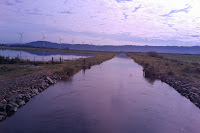Site Description
The wind farm at Osório stretches 13 km long by 7 km wide (approximately 9000 hectares) with 148 wind turbines, each with a capacity of 2.3 MW. Our tour started with a visit to the substation control room, continued with a coffee break and a presentation about the companies involved, and concluded with us going to the base of one of the turbine towers.
Last year, Ventos do Sul produced enough energy to power 450,000 Brazilian homes, or approximately 1.5 million people. 60% of this production occurred in September, October, November, and April, with a significant drop off during the summer and winter months. The site only produces energy for 50% of the year. This may not sound great, but the typical wind farm in the United States is producing energy only about 30% of the time. This higher efficiency can be attributed to two things: great site selection, and smart turbine designs. Osório is a great location for a wind farm because it is flat and exposed on three sides with a mountainous backdrop to the West. The winds typically flow from the Northeast, reducing the amount of movement the turbines need in a given day. Also, each turbine is equipped with an anemometer and a built in computer which will tell the turbine when to turn on or off and the ideal orientation for the head to be pointed.
 |
| Ventos do Sul owns 172 turbines spread over 6 farms, accounting for a 375 MW capacity |
How the turbines work
Basically, a turbine works like a box fan, just in reverse. Whereas a fan uses energy to turn blades to make wind, a turbine uses wind to turn blades to make usable energy. The turbines used by Ventos do Sul are 110 m tall (from the base to the top of the blade diameter) and utilize 35m long blades. These turbines operate at windspeeds from 2.5 m/s up the 25 m/s (6 mph to 55 mph). Too little wind, and the blades won't turn. Too much wind and the internal mechanism can not keep up with the blades. The turbines at Osório are most efficient in wind speeds around 11-12 m/s. This large range of operational speeds is due to Ventos do Sul's use of newer turbine models. Designed by German engineers, these turbine use a direct drive system in the turbine head, getting rid of internal gears featured in previous models and simplifying the entire process.
 |
| Diagram snagged from Ventos do Sul's on-site learning center |
Environmental Concerns
In previous wind turbine designs, a large concern for widespread use of wind power was the turbines' impact on bird flight paths. The turbines in Osório utilize longer blades with a much slower rotational speed, making the blades easier for birds to avoid. Additionally, the birds of the region tend to stay below 30m in elevation, 10-15 meters below the lowest point in the blade path. An environmental impact study concluded that between 2006 and 2014, the turbines at Osório were responsible for less than 0.5 bird collisions per turbine per year.
Another advantage to the newer turbine design is a significant noise reduction per turbine. These turbines were nearly silent -- we couldn't here them even when we were at the base of one of the towers. The lack of noise pollution allows local landowner to continue to use most of the land around the towers for regular farming operations. The wind farm at Osório was covered in livestock, rice paddies, and fishing ponds; only 3% of the land here was used for wind turbines.
During construction of the first turbines at Osório in 2006, Ventos do Sul performed a life-cycle assessment of the structures being constructed. This assessment included construction, 30 years of operation, and demolition. The researchers found that, when compared to conventional methods of energy production (i.e. fossil fuels), the wind farm actually has a positive carbon footprint, with the same contribution as taking 536,000 barrels of oil out of use per year. The company representative did not say whether this life-cycle assessment also included the embodied carbon of the steel or concrete used in the turbines.
 |
| 97% of the land at the Osório Wind farm is used by local farmers for livestock grazing and rice farming. |
 |
Ventos do Sol is owned and operated by Enerfín, which is the renewable energy division of Elecnor, a Global leader in energy infrastructure concessions and construction. A concession company is one that makes money by owning and maintaining projects for a set length of time (20-30 years in Elecnor's case), and then reaping the benefits once the contract is completed. Enerf[i]n controls a global capacity of 2315 MW in wind generation, and has sites in Spain, Brazil, and the United States [and one more... look this up]. This amounts to approximated $500 million (US) in operational wind farms.
Moving forward, Ventos do Sul plans to expand their capacity, with 188 MW worth of turbine's to be installed in the coming years. As far as constructability is concerned, Ventos do Sul was able to build 75 turbines in the first 15 months of operation (approximately 1 turbine per week). After they gained some experience, Ventos do Sul was able to increase that efficiency to almost 3 turbines per week during their last major construction phase, in 2014.
 |
| The annual capacity maintained by Ventos do Sul is equivalent to removing 160 thousand cars from the road. |

No comments:
Post a Comment